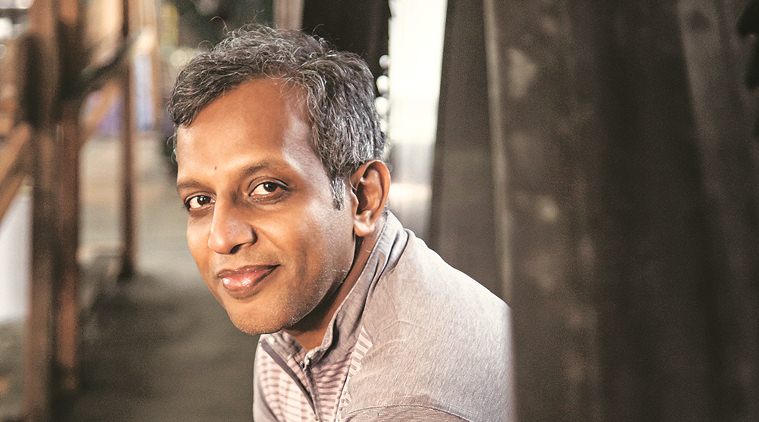- India
- International
Artist LN Tallur builds connections between the past and the present and urges viewers to question the obvious
Comprising 27 works from 13 years, the showcase has Tallur experimenting with the medium of bone meal and film for the first time, but there are common strands that connect with several of his previous works — his engagement with the past and how it affects the present.
 Arguably his biggest show in the US, the other part of the title comes from a slow motion video, titled Interference, that shows dust being beaten out of an 18th century rug, woven by jail inmates, at the Junagadh museum in Gujarat.
Arguably his biggest show in the US, the other part of the title comes from a slow motion video, titled Interference, that shows dust being beaten out of an 18th century rug, woven by jail inmates, at the Junagadh museum in Gujarat.
TOWERING 18 feet tall and made with bone meal, bone char and crushed bone, LN Tallur’s Fringe has a spiral contortion of skulls jutting out of a mountainous structure. Occupying a large space at the Grounds For Sculpture — a sculpture park and museum in Hamilton — Tallur says the artwork is a dialogue between the present and the past. The work, he says, is based on fragments of a historic Indian temple in the collection of the Philadelphia Museum of Art. The artist carefully scanned the fragments and the digital files formed the premise of his own work. “It’s a 10th century sculpture, probably made in Madhya Pradesh. The two figures are starved and the body skeleton is visible. While one figure is masturbating, the other is busy eating the foot of the masturbating figure. It’s actually hard to interpret the work and the museum text displayed alongside has changed four times. I see my work as a dialogue with the sculptor, who would have had to adhere to several rules back then,” says Tallur, 48.
The monumental work forms the partial title of his solo “Interference Fringe”. Arguably his biggest show in the US, the other part of the title comes from a slow motion video, titled Interference, that shows dust being beaten out of an 18th century rug, woven by jail inmates, at the Junagadh museum in Gujarat. Fascinated with how the rug was cleaned and surprised to see how much dust it blew out when he was visiting the museum early this year, Tallur decided to film the act with a 4K phantom camera, which shows the dust in slow motion. “The carpet used to be at the Durbar Hall at Junagarh Palace. All those who visited the hall would have left their dust marks. It might have had dust from the king of Junagadh or British officials or even our own government officials,” says Tallur.
Comprising 27 works from 13 years, the showcase has Tallur experimenting with the medium of bone meal and film for the first time, but there are common strands that connect with several of his previous works — his engagement with the past and how it affects the present. “History is not just a mirror to our past, it is also a mirror to our present and future. Museums try to conceptualise objects to present the current needs of a country. I, too, see these objects in the contemporary context,” says the artist. In the sculpture Unicode, for instance, the frame that usually surrounds the figure of Shiva as Nataraja, has a huge ball of rough concrete with coins on its surface. The image comments on the perception of money being evil, and how the world now revolves around it. The installation Chromatophobia, meanwhile, more directly addresses the notion that “money is the root of all evil”. Tallur invites viewers to hammer coins into crevices of the wood.
 LN Tallur
LN Tallur
Born in Koteswara, a village in Karnataka, Tallur spends his time between Seoul, where his wife is from, and Bengaluru, where he often collaborates with skilled craftspeople and technicians. “Living in different cultures, different economies and different geography gives a unique perspective to life and certainly influences the art,” he says. A post graduate in museology from MS University, his academic background also influences his art practice. Curious on how to engage with museum visitors, his dissertation explored multi-sensory approaches in exhibition design. “I try to see objects in the contemporary context,” says Tallur. There is also questioning the past. “Museums are repositories of history, but whose history?” he adds. Reflecting this thought is a stone work in the exhibition, Milled History, based on a wooden copy of a temple figure that he kept in his backyard in India to be infected by termites. The remains were digitally scanned and milled in sandstone.
 Unicode comments on the perception of money being evil, and how the world now revolves around it.
Unicode comments on the perception of money being evil, and how the world now revolves around it.
While he has held solos in Germany, South Korea, India, China and the US, he won the Skoda Prize for his 2011 exhibition “Quintessential”, held at Dr Bhau Daji Lad Museum in Mumbai. It had Tallur responding to works in the museum collection, where he referred to the fifth dimension an object attains when placed in a museum (a further addition to Einstein’s four dimensions). One of the works from the exhibition is now showing in the US. Titled Hath Yoga, the “nail manufacturing machine” has a reclining figure of a sadhu on a bed of nails, from the museum’s repository of objects.

In the ongoing exhibition, we also see Gandhi. Both Eraser Pro and Iron Age have fragments of his frame, playing with the negative space and prompting viewers to interpret his ideals beyond the mainstream narratives — much like Tallur’s other works where he provokes them to look beyond the obvious.
Apr 25: Latest News
- 01
- 02
- 03
- 04
- 05



































